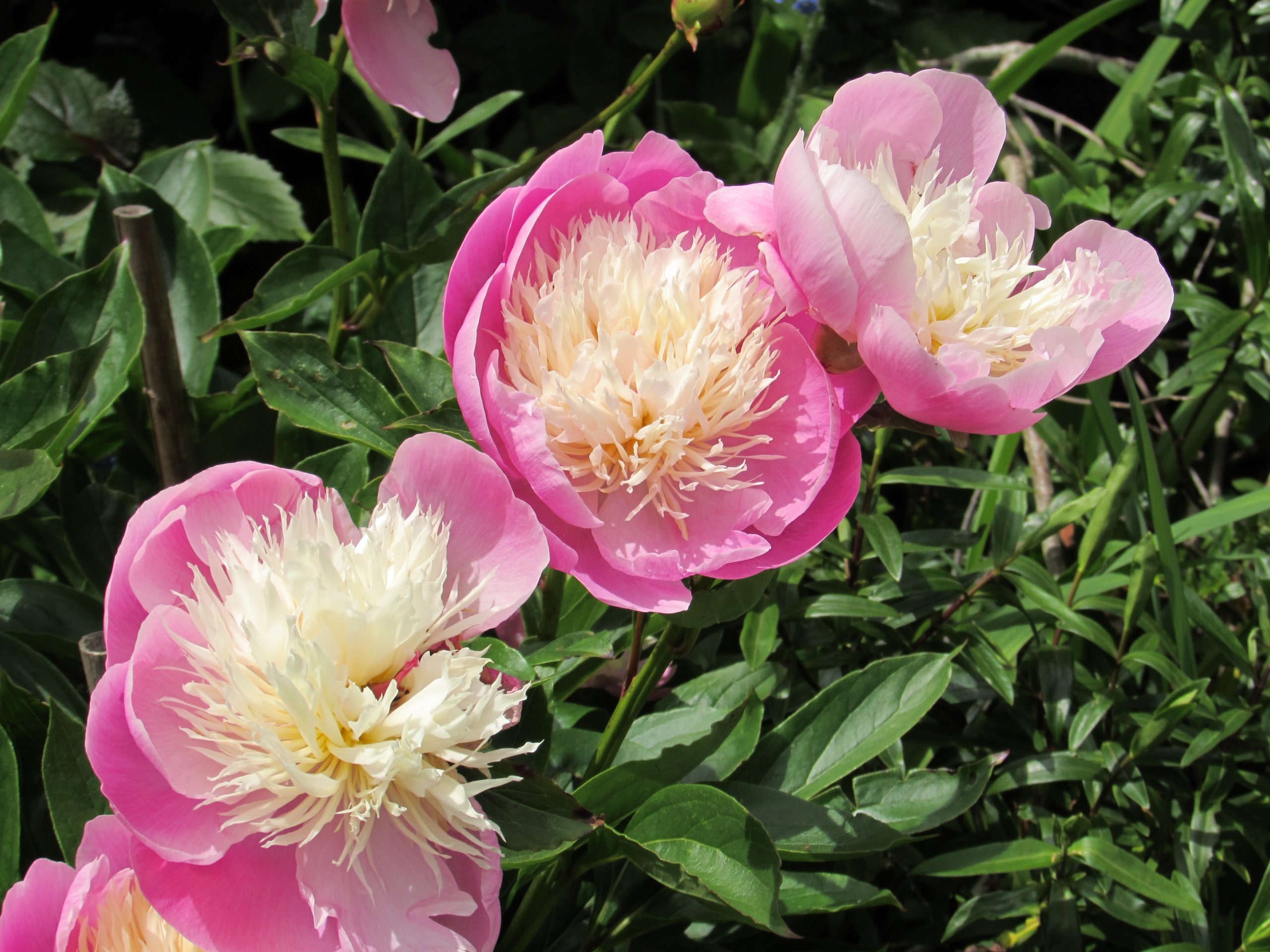 JULY
JULY
Flowers
Autumn-flowering bulbs, such as autumn crocuses, Colchicum, Sternbergia, Amaryllis and Nerine, can be planted now.
Divide spring-flowering plants such as Irises now or during the next two months.Take cuttings of patio and container plants ready for next year. Last chance to sow biennials for next year – Sweet William, Wallflowers and Foxgloves.
Pinks and carnations that have become leggy can be propagated by layering or by cuttings. Propagation can improve the appearance of untidy clumps.
Prop up tall perennials such as lupins, delphiniums and gladioli if staking was neglected earlier in the season.
Liquid feed containerised plants and keep well-watered in dry spells.
Some late-flowering border perennials may benefit from a quick-acting feed before they come into bloom, especially if the soil is not very fertile.
Agapanthus thrive in sunny spots and free-draining soil where they won’t be overshadowed by taller plants.
Start collecting seed from plants you want to grow next year, especially annuals such as Calendula, poppies and love-in-a-mist.
Inspect lilies for the scarlet lily beetle whose larvae can strip plants in days. Pick off any you spot by hand.
In dry weather a silvery white coating may appear on the leaves of plants such as clematis, roses and Lonicera, caused by the fungus powdery mildew. Although it’s unsightly, it’s not usually harmful to plants.
Vegetables
Pick courgettes before they become marrows
Continue to make small sowings of salad crops
Lawns
Keep mowing regularly, except during drought. In hot weather, set the mower at a slightly higher level than normal for early summer to stop the lawn drying in hot weather. Don’t worry about brown patches on the lawn – they will recover quickly when the autumn rains arrive.
New areas of grass, sown or turfed in the spring, will need extra watering to keep them going through their first summer.
Lawn growth slows down in late summer. Raise the cutting height slightly as the month progresses, to help the grass better resist the wear it suffers in summer.
Ponds
Top up ponds and water features if necessary.
Any pumps on water features should be left on during sultry nights, as oxygen levels are lower in such conditions.
Remove dead foliage and blooms from waterlilies and other aquatic plants. Cut back any marginal plants that are getting out of hand. Continue to skim blanket and floating weeds.
General maintenance
Mulching borders can help retain moisture and keep down the weeds.. A really thick mulch (5-7.5cm / 2-3in all over) works best.
Most perennial weeds are best dealt with in the summer when the weeds are in active growth.
AUGUST
Flowers
Take cuttings of tender perennials such as Pelargonium and Osteospermum, as soon as possible. A greenhouse, cool conservatory or a light windowsill are ideal to bring them on until they are established.
Rock garden plants, such as Helianthemum, Aubrieta and Dianthus can be propagated from cuttings now.
Collect and store seed of hardy annuals and perennials for sowing later in the autumn. Good plants to try include Calendula, Nigella, Cerinthe, Papaver, Aquilegia and hardy Geranium.
Buy or order spring-flowering bulbs. Some bulbs can be planted now, such as Colchicum, daffodils and Madonna lilies (L. candidum).
If your dahlia blooms are ragged, earwigs are the likely culprits, so fill small pots with shredded newspaper and place upturned on canes to trap them overnight.
Don’t be worried by bright green, heavily-armoured looking insects on your plants – these are harmless shield bugs which do not require control.
Vegetables
Sow seeds of spring onions, radish, mixed lettuce, leaf salad winter mix, spinach, beetroot, green manure,
Ponds
Clearing out fallen leaves and debris regularly will help to keep down algal growth, as there will be fewer nutrients available from rotting organic matter. Barley straw pads or extract may also be beneficial.
Lawns
Raise the blades on the mower before cutting fine lawns. This will help reduce drought stress.
Mow lightly and frequently so that short grass clippings can remain on the lawn during hot summers to act as a moisture-retentive mulch. Excess thatch can be scarified out during autumn maintenance next month.Lawns on thin soils may benefit from a high phosphate feed. This will strengthen the roots for winter, rather than encouraging lush top growth that could suffer in the cold and weaken the grass.
Dig over any areas due to be grassed over later in the year. Leave them for a few weeks to allow weeds to re-emerge, and then hoe off to ensure thorough weed clearance before seeding or laying turf in the autumn.
Browning of the lawn is very common at this time of year. Don’t water the grass. It will green up when the autumn rains arrive.
SEPTEMBER
Flowers
Divide summer-flowering plants now or during the next two months.
Sow sweet peas in a cold frame or the greenhouse for early summer blooms next year.
Sow other hardy annuals (e.g. Consolida, Calendula, Centaurea, Limnanthes and poppies) in situ.
If you sowed any spring-flowering biennials such as Viola, Digitalis (foxglove) or Erysimum (wallflowers), earlier in the summer, they will now need planting out.
This is a good time of year to plant new perennials, especially towards the end of September, as the soil is still warm, but moisture levels are increasing.Take cuttings of tender perennials, such as Pelargonium and Osteospermum. These plants often do better grown from new cuttings each year. If you do not have a greenhouse, then use a light windowsill to grow them on.
Continue collecting and storing seed from perennials still forming seedheads.Bring inside any tender perennials, such as fuchsias, gazanias, lantanas and abutilons, before frosts cause damage.
Some tall late-flowering perennials, such as asters, may still need staking to stop them being blown over in the wind. Spring-flowering bulbs are now available in plant centres, garden centres and online. Best prices at J. Parker’s wholesale, who sell a wide variety of spring bulbs at a fraction of the price of garden centres – tulips typically cost from £14 – £35 per hundred, but you only need to buy a minimum of 25 to qualify. Catalogues from www.dutchbulbs.co.uk in the autumn.
Vegetables
Sow seeds of mixed winter mix salad leaves, lettuce Reine des Glaces, Winter Density. Lobjoits Green, Italian mix, Rocket and Jack Ice, Corn salad (Lamb’s lettuce), Cauliflower, Spinach, Carrot,If the weather is already autumnal, you can now plant and move shrubs and trees.
Lawns
Mow less frequently during autumn, and raise the height of cut as the growth rate of the grass slows down. This will help the lawn to withstand the last of the warm, dry weather, and keep it resistant to treading as the wet weather arrives.You can harden your lawn up for winter by applying an autumn lawn feed, which is high in potassium. Do this after scarifying and aerating but before applying a top dressing. Do not give summer feeds that are high in nitrogen as this will only result in weak, soft growth, which will be prone to disease in the autumn weather.Loam and sand top dressings are usually applied at a rate of 2kg per sq m (4.5lb per sq yd), working them into the lawn with a stiff brush or the back of a garden rake.
This is an ideal time of year to create new lawns from turf or seed.Rectify summer damage by repairing a patchy lawn with turf or seed. Any brown patches caused by drought will quickly green up by themselves when the rain comes and the temperatures fall – usually towards the end of the month. Good autumn lawn care will do much towards solving patches caused by problems such as fungi (e.g. fairy rings), moss and weeds. These problems usually develop on lawns that are already weakened by poor conditions – waterlogging, drought and compaction, for example.
Ponds
Cover the surface of ponds with netting to stop fallen leaves from entering. Accumulated debris in the pond can encourage growth of algae and weeds, which will eventually harm the fish by reducing available oxygen levels.
Top up water levels when necessary, particularly during warmer weather, and continue to remove blanket and duckweed.
Remove dead leaves from waterlilies as the foliage dies back. Now is also a good time to divide waterlilies and other pond plants to increase stocks or control over-vigorous growth.
Overgrown marginal plants can just be cut back, if further stocks are not required. A maximum of 50 percent of the water’s surface should be taken up with planting.Waterlilies can be prone to fungal problems such as crown rot and leaf spot. Remove affected leaves, reduce watersplash from fountains and, if necessary, repot the whole plant in fresh compost after first removing all rotten looking bits of root, stem and leaf.

